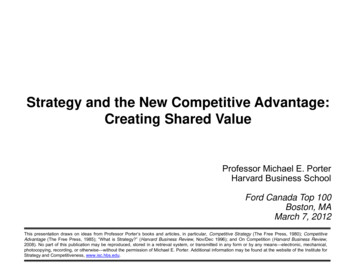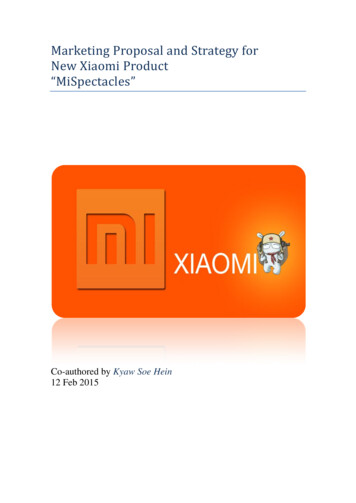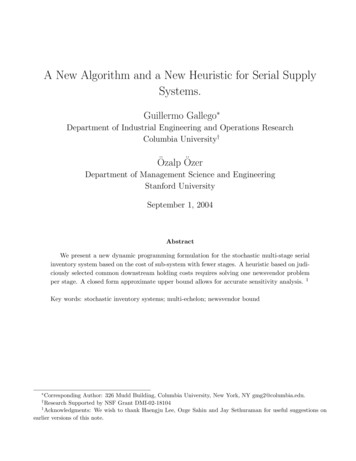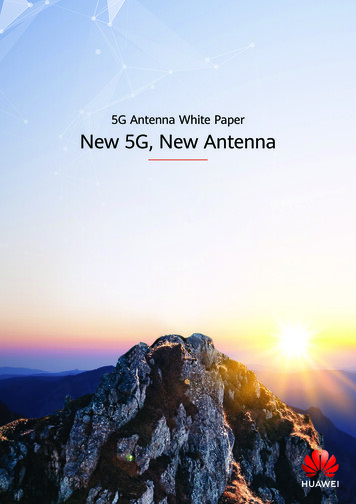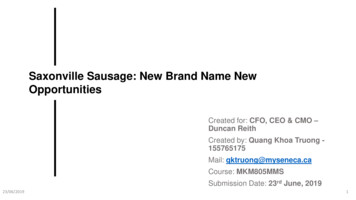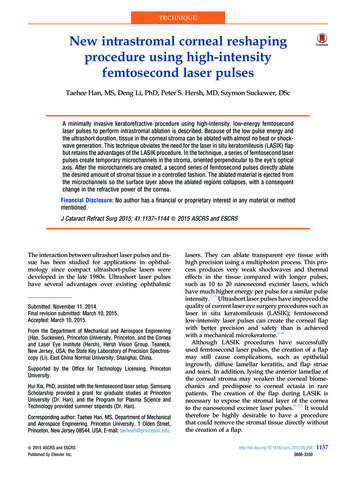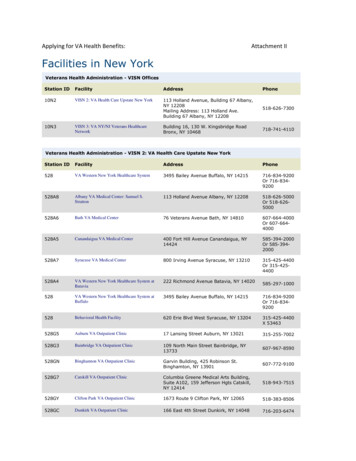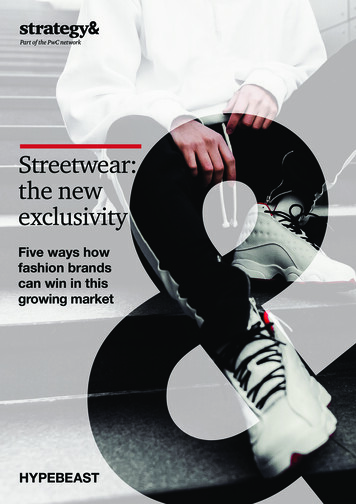
Transcription
Streetwear:the newexclusivityFive ways howfashion brandscan win in thisgrowing market
ContactsAustriaHarald DutzlerPartner, PwC Strategy&Austria omWillibald KoflerPartner, PwC Strategy&Austria .comLaura LeebDirector, PwC Strategy&Austria ermanyDr. Axel NitschkeDirector, PwC Strategy&Germany mAbout the authorsLaura Leeb advises clients across Europe in theretail and consumer sector. She specializes inhelping clients in the food and fashion industryrefine their portfolios and strategies, as wellas in supporting to make their supply chainsmore integrated and sustainable. Laura is aDirector with PwC Strategy& Austria, basedin Vienna and London.Dr. Axel Nitschke advises clients in the retailand consumer goods sector, focusing onfashion and sportswear. His key areas ofexpertise are strategy development, digitalretailing, customer experience and value-chaintransformation. He is a Director with PwCStrategy& Germany, based in Düsseldorf.Enrique Menendez was formerly the seniorfeatures editor at HYPEBEAST, dedicated tomaintaining the quality content flow of originaleditorial features and overseeing digitalcovers. He is based in New York.Philipp Hallegger, Katharina Schaper, Sarah Nolte, Nick Reiff, Christina Laake, Daniel Magar (Strategy&),Jeremy Grant (PwC), Emily Jensen, and Jake Silbert (HYPEBEAST) also contributed to this report.Please visit t for full streetwear impact report.
EXECUTIVE SUMMARYStreetwear is one of the most striking retail and fashion trends to haveemerged in recent years, involving the production, promotion, sale andresale of casual fashion – mainly footwear, T-shirts and other items – inways that bypass traditional retail channels.Customers are often rallied via social media to be the first to buy products that are onlyavailable directly from the brand, either in-store or online. The anticipation of a time-limitedchance to buy, helps create a tight-knit and almost cult-like relationship between streetwearbrands and their consumers.This has helped propel streetwear from being an eye-catching fashion phenomenon thatdrew its inspiration from the counter-cultures of the 1980s and 1990s – including graffiti,hip-hop, skate and surf – into a multi-billion dollar retail market. We estimate the size ofthe global streetwear market at 185 billion by sales1, making it by some estimates about10 percent2 of the entire global apparel and footwear market.Streetwear’s impact – both on retail culture and the numbers involved – has caught theattention of some of the most iconic, established brands in the retail and luxury goodssectors and fashion industry generally. Streetwear players come from various parts of thefashion industry. There are pure streetwear brands such as Supreme and Stüssy, whilesportswear names such as Nike are developing their traditional portfolio of sports equipmentinto a growing streetwear portfolio of cool, hip sneakers and hoodies. In addition, luxury brandsare working to gain a significant stake in the streetwear market (see Exhibit 1, next page).1. Estimate based on US Streetwear Market Report data (2015) which has been extrapolated with Euromonitor (2019) fashion marketgrowth rates.2. Based on data from Euromonitor (2019).I wasn’t intending to bring street fashion to Japan, I wassimply just introducing the things I liked. That includesitems from Tiffany, documentary films from Japan, andvarious other things. It just so happened one of thosethings was skateboarding – that’s all it was.”HIROSHI FUJIWARA, FRAGMENT DESIGN FOUNDERStrategy& Streetwear: the new exclusivity1
EXHIBIT 1Top streetwear brandsWhich brand represents streetwear to you the most? .6%Stüssy33.2%Palace27.3%Carhartt ource: Streetwear Impact Report – percentage of records from consumer surveyThat’s in large part because it is opening up a whole new target market of younger consumers.Streetwear’s audience is very young: mostly under 25.A second reason for the interest from established brands is that streetwear has subverted theway fashion trends have taken off. The fashion industry has typically operated a top-downmodel, with insiders acting as gatekeepers to the newest styles and trends. Streetwear hasturned this on its head. Customers have the power to determine what’s cool as much asindustry insiders. Exclusivity and desirability are conferred by scarcity and insider knowledgerather than high prices. In short, streetwear has redefined how “cool” is made profitable.Third, streetwear’s democratic values are increasingly shared by all consumers, for whomthe opinion of peers is an ever-more influential part of decision-making: 32 percent ofrespondents to PwC’s recent Global Consumer Insights Survey (GCIS) said positive reviewson social-media influence what products they buy.Small wonder, therefore, that fashion brands have been buying into the streetwear trend in recentyears. Among the highest profile examples are Louis Vuitton’s collaboration with leadingstreetwear brand Supreme, and the luxury giant’s decision to hire Virgil Abloh, founder ofstreetwear brand Off-White, as artistic director of Louis Vuitton menswear last year.2Strategy& Streetwear: the new exclusivity
Strategy& and Hypebeast, a leading online media platform for contemporary fashion andstreetwear, recently conducted two surveys to show how fashion brands can best succeedin streetwear: one covering more than 40,000 consumers worldwide and another involvingaround 700 people working in the industry. The results showed that: 25 years oldStreetwear consumers are young:more than 60 percent of consumerssurveyed were under 25. 40,000They aren’t all that wealthy, either:about 70 percent of respondentsreported an annual income of 40,000 or less. 100 – 30053%But they have money to spend on their favoritebrands: 56 percent reported spending anaverageof 100– 300 on a single item. Asian consumersspend more, with 32 percent of Japaneserespondents spending an average of 500 ormore per product.84%42%They connect directly with brands both offline andonline: 53 percent are most likely to buy streetwearproducts in the brand’s own store; 42 percent fromits website.Social media is their top source(84 percent) of influence, followedby the other young, urban peoplethey see around them.65%70%Streetwear’s young fans think of themselvesas being socially conscious, a trend that isspreading to all consumers: 70 percent saidsocial awareness and brand activism wereimportant to them, while 29 percent of PwC’sGCIS participants said they buy brands thatpromote sustainable practices.Successful brands have stronglinks to the cultures out of whichstreetwear grew: musicians have themost credibility among consumersin our survey (65 percent), someway ahead of social-mediainfluencers (32 percent).Growth expectations for streetwear are robust, even as there are some clouds gathering overthe retail industry amid fears of a global economic slowdown: as many as 76 percent ofindustry respondents in our survey expected the market to continue to grow significantlyover the next five years.With this landscape in mind, we have explored how brands can play – and win – in thestreetwear market. Five factors should be borne in mind for success: authenticity; scarcity;democracy; affordability; and seamlessly linked online and offline activity.Strategy& Streetwear: the new exclusivity3
FIVE WAYS TO WIN IN STREETWEAR1. AuthenticityThe challenge for most fashion labels is to stay relevant by redefining themselves every fewyears. Streetwear succeeds by staying true to its origins: 62 percent of consumers in oursurvey said streetwear products are always in style, surviving fashion’s traditional cycles dueto their versatility.Yet to achieve this timeless appeal, brands must live up to the very high standards set bystreetwear’s young and discerning customers – and demonstrate authenticity.A majority (70 percent) of survey respondents said campaigning on social issues and brandactivism were important to them. Almost half (47 percent) of respondents reported they werelikely to stop buying items from a brand if it was seen as behaving inappropriately.How can brands, particularly those with no historic links to any of the cultural influences ofstreetwear, offer authenticity? Define your brand by emphasizing your heritage, telling your story, building on what youreally stand for and investing in differentiating capabilities. Establishing an authentic brandpurpose is a crucial way to reach audiences in a crowded digital field: “If you can usetechnology to gain entry, and then tell a story that is engaging to consumers, then thereis a good chance of success,” former Saks Fifth Avenue chief executive Stephen Sadovesaid in an interview for PwC’s GCIS. Listen to your consumers, react quickly and continually assess how new products andpromotions fit with consumers’ expectations of your brand’s image and roots. Build relationships with true innovators and creators in the worlds of music, art, fashionand sustainability to innovate together. Streetwear is still very strongly linked to itscultural roots in hip-hop and graffiti. Musicians, industry insiders and contemporaryartists were all viewed as more credible sources than social media influencers, celebritiesor athletes, according to our survey. Therefore, brands should build meaningful links withtrue innovators and creators in these fields, rather than seek superficial promotion viaprofessional influencers (see Exhibit 2, next page). Provide proof of commitment to issues such as sustainability and the circular economy toshow that your actions live up to your words. Adidas, for example, brought out the firstfully recyclable running shoe earlier in 2019, saying the sneakers were “a statement of ourintent to take responsibility for the entire life of our product.”33. Wallpaper (2019) – adidas launches first fully recycable sneakers; ly-recyclable-sneaker4Strategy& Streetwear: the new exclusivity
EXHIBIT 2Measuring influenceWhich factors are the most importantfor brands? (consumer)Product quality/design81.4%Brand iavaluepresence 25.3%30.9%Which figures do you consider mostcredible in streetwear? 7%Industry insiders51.8%Contemporary artists44.5%Creative ce Brick &experiencemortar10.3%8.0%Source: Streetwear Impact Report – percentage of records from consumer surveyThe art world has a tendency to feel a little bit hard to enterfrom the outside if you’ve never been or you just didn’t growup in that kind of culture. And part of it is because artworktakes a lot of effort and a lot of time to create and there’s arespect that needs to be given to that. My involvement withthe projects that I’ve done with adidas and the sneakers Ihave created, allowed me to bridge those audiences.”DANIEL ARSHAM, CONTEMPORARY ARTISTStrategy& Streetwear: the new exclusivity5
2. ScarcityWhile exclusivity in the luxury sector is mostly driven by premium prices, exclusivity instreetwear is mostly driven by scarce supply. To succeed in this market, brands mustunderstand and master the dynamic of limited availability, starting with the drops model.Traditionally, high fashion products or collections are first shown to the public in runwayshows; new mainstream fashion collections are often not announced at all beyond theretailer’s regular advertising. However, streetwear introduced a new way of bringingproducts to the market, known as drops. Customers queue outside the brand’s store onthe appointed day and are allowed in, in batches. Individuals may only have 15 minutesin the shop and can buy a maximum of six items.4Brands also build demand ahead of a drop by giving products to high-profile figures to wear.For Virgil Abloh’s “The Ten” sneaker collection by Off-White and Nike, personalized versionswere given to celebrities including basketball star Michael Jordan, musician Drake and themodel Naomi Campbell ahead of the official release.4. The Economist 1843 magazine (2017) – The hype economy; yAs soon as supply is greater than demand, that product’s notscarce anymore. So it’s not cool to a certain group who wantsthat totally unique self-expression. They don’t want to possiblywear something that any person off the street can just walk inand buy. That cool 17-year-old kid doesn’t want to wear thesame shoes that my mother wears.”JOSH LUBER, CEO AND CO-FOUNDER STOCKX6Strategy& Streetwear: the new exclusivity
In an earlier innovation by Nike, in 2015 the company introduced a lottery called SNKRSthat picked at random from those who signed up for a new drop and allocated them a slotthat allowed them to purchase the shoe. By making the new product scarce, increasing itsdesirability and only available from Nike directly, the company was able to have the kindof direct communication with its customers that all fashion brands crave, both for brandawareness and sales reasons.Done correctly, drops enable brands to build momentum and to actively steer demand toexceed supply. Creating scarcity in this way increases the hype and demand for certainproducts even further. Companies that are new to the drops model can invest in predictiveanalytics to simulate demand and supply, in order to drive scarcity without risking producingtoo little of a sought-after product.Scarcity also drives another unique feature of streetwear – a booming resale market.Supreme box-logo crewnecks, originally sold for 158, resell for a m
4 Strategy& Streetwear: the new exclusivity FIVE WAYS TO WIN IN STREETWEAR 1. Authenticity 3. Wallpaper (2019) – adidas launches first fully recycable sneakers; ly-recyclable-sneaker The challenge for most fashion labels is to stay relevant by redefining themselves every few years. Streetwear succeeds by staying

